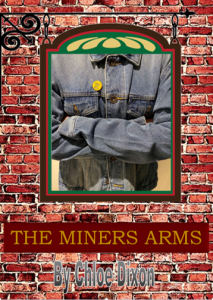Paint, Hugs & Rock n Roll – An Ensemble Visual Texts Performance
Catalogue Document – http://eportfolio.yorksj.ac.uk/view/view.php?id=99284
In my first year one of the modules we were given was a module that was all about creating and performing contemporary and abstract theatre, we were given a visual aid and tasked with creating a performance that was to be performed outside in our university quad.
Our stimulus for this project was the artist David Hockney and his work. The point of this piece of theatre was that it was mostly visual, we created a string of images with movement and used brightly coloured props (such as painted wooden boards and beach towels) as well as funny costumes, wigs and glasses and paintbrushes. However, we also added music which fit perfectly with our images.
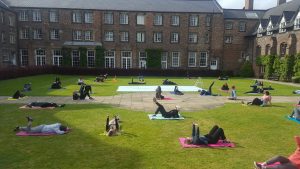
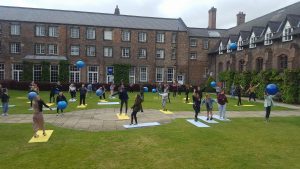
This piece was both strange and evocative but extremely fun. This was one of the first pieces that taught me that contemporary theatre doesn’t necessarily need to make sense to carry meaning and that making theatre solely from images will still get our story across. It also taught me that sometimes the visual speaks to people just as much as a piece of text can, just having bodies in a space is sometimes enough and you can make visual performances from any stimulus. This process helped me create work throughout my course duration, it was an enjoyable experience that really gave us creative freedom.
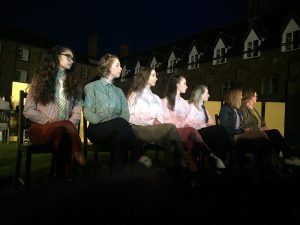
Truth Be Truth To Th’ End Of Reck’ning – An Artist as Witness Performance
Catalogue Document – Artist as Witness
In my second year, we had a chance to be involved with the Artist as Witness module, this module was all about creating a performance based on what we as performers and people had witnessed. This module was difficult and thought-provoking but ultimately rewarding.
This module was difficult for me personally as we were focusing on emotional subjects, I also felt it was difficult for me to show up with an idea and because I couldn’t see the end result of the performance I struggled with the process. It was a long process filled with lost images and ideas that didn’t make it to the final piece, the process was also filled with endurance as we took it upon ourselves to make sure we were working extremely hard both emotionally and physically to the point where we’d be sweating profusely…though that was the idea.
Our stimulus for this piece was the holocaust within a take of Shakespeare’s Measure for Measure. Basing a performance on such a horrible act of cruelty made us realise how important it was to shine a light on individual stories, making sure no one was left out or lost in history. We knew we could not reenact these things, anything we performed and any story we told would always be slightly different to the original experience, but we could pay homage to them. We used a setup much like a living room or a big group ‘hangout spot’ as our base for the set, where we all started from that point and we all went back to that point as a ‘safe place’, much like safety in numbers, after telling a story or making an image.
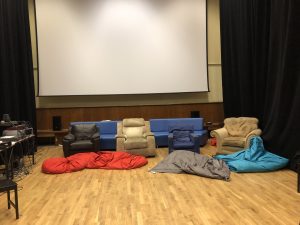
Our piece was reliant on storytelling and making images from those stories. This resonated through other pieces of work and performances, particularly helping us create images for a group module in our third year by thinking back to this module and using this module’s structure (or lack of) to build ideas for other things.
For me personally I liked having a structure and so I knew I would not necessarily be able to use this on my own to create a piece of my own work, however the module has stuck in my head as an exceptional learning curve and will always be one of the most important modules I was a part of on my degree.
The Miner’s Arms – An Independent Practise as Research Performance
Catalogue Document – The Miner’s Arms
In my third year, I undertook the hardest module I had ever faced, this module was one of the biggest learning curves for me in my three years on this course. It taught me a lot of things about myself as a person and a performer. The Independent Practise as Research (IPaR) module was all about creating a piece of work that was entirely your own, using all of the techniques and knowledge that we had acquired in the last two years we had the freedom to create a personal performance.
The Miner’s Arms was a play set in a pub that included a lot of music and was based on a story about what it was like to live in the north east of England in the 1980’s, specifically around the time of the miners strike.
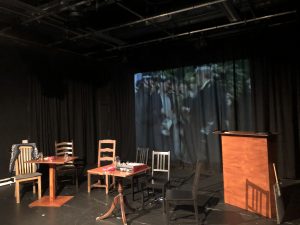
The process of making this performance was all about trying to play and create new ideas, to explore the story I was trying to tell and to make interesting characters to tell the story. Making this piece took me out of my comfort zone, I had to do things and try and create things that I had never done before. However I managed to create a piece that told a story and took the audience on a journey, with the use of conversation dialogue, monologues and music from the era. Including music was very important to me as I believe music speaks to people in a different way.
This was a very different way of working for me, however, it made me grow as a performer and as a person, it made me learn lots of valuable lessons about the balance between performing and devising and it took me on an incredibly interesting creative journey.
Making and being part of The Miner’s Arms has set me up to be more confident about my own work and my ability and has made me gain skills I know will be extremely valuable in the future, as both a creator and a performer.
